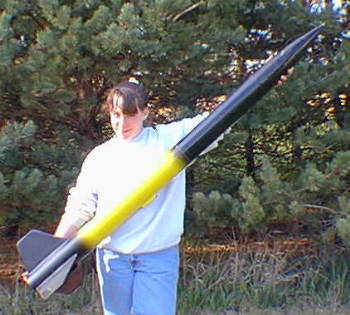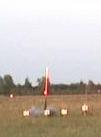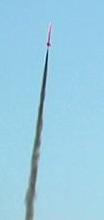
(Contributed - by Brian Wheeler)
photo courtesy of Steve White and
Magnum 
Brief:
Mid to High Power kit. The Falcon features easy assembly, 54mm motor mount, big
36" parachute, and a 17" payload tube.
Construction:
The Falcon had one main body tube and one payload section. It had 3 plywood
fins, and a 54mm motor mount. I believe the shock chord is 1 inch strap
elastic, and the nose cone is plastic. The launch lugs are half inch.
The instructions were extremely easy to follow, and it goes together perfectly if built exactly per instructions. The kit is extremely sturdy, and I would feel no hesitation to fly it on a full slow burning J motor. I would recommend a 29mm or 38mm adapter for the kit (supplied), though, because it flies quite nicely on even G motors, for extremely slow and low flights.
Finishing:
Finishing was easy. There are no decals provided or recommended paint schemes,
so I sprayed mine with a fade from orange to yellow to white, and it looks
quite nice.
Construction Rating: 5 out of 5
Flight:
The recommended motors are G125-5, H125-5, and I125-10. Whatever... I've flown
mine only twice, and since I'm only 15 and my dad just now got his level 1,
I've flown mine only on G motors.

 The first
flight was a an Aerotech G-38. This had to be the slowest flight I've ever
seen, and the winds were gusting about 15 mph, but it flew straight and true,
and the 4 second delay was perfect, right at apogee. It did require a fair
amount of wadding, but the chute came out perfect, and there were no signs of
anything being scorched or burned.
The first
flight was a an Aerotech G-38. This had to be the slowest flight I've ever
seen, and the winds were gusting about 15 mph, but it flew straight and true,
and the 4 second delay was perfect, right at apogee. It did require a fair
amount of wadding, but the chute came out perfect, and there were no signs of
anything being scorched or burned.
That night, we had a night launch, so I took advantage of it, with much help from the Houston/NASA rocket club. We loaded it up with a G-80, and the 15 glow sticks with streamers, unfortunately, leaving only one for the outside of the rocket, but nonetheless, I flew it in the pitch black night. The boost was awesome with the purple flame, and once again with a four second delay, apogee was absolutely perfect, and the fifteen glow sticks came out, all perfect, as well as the parachute, and created a beautiful cloud of light. It took nearly an hour to find it, but I got it back, with the help of two other people searching the entire recovery area, and it was once again in perfect shape.
Recovery:
The shock cord was attached to a metal string which is then attached to the top
centering ring. This method has never failed for me, and on this kit, it was
perfect. recovery had no problems with speed or anything getting damaged.
Though I've flown mine only twice, I've had no problems at all with damage on
recovery
Flight Rating: 5 out of 5
Summary:
I feel that everyone should own this kit. I've had many kits near this range,
and none of them have been able to compete with the versatility and strength of
this kit. I see no real con's with this one.
Overall Rating: 5 out of 5
 |
 |